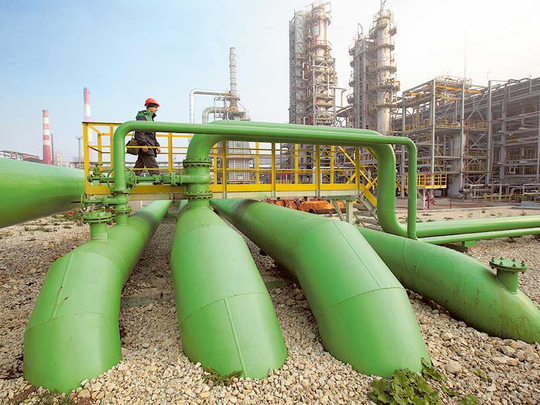
Dubai/Istanbul: Opec’s effort to secure cooperation of non-members in a global deal to curb crude output will roll on from Istanbul to Vienna, with Russia on board but growing internal differences over sharing the burden of cuts.
Russia is ready to participate in a “technical exchange” to set a road map for oil production levels in the Austrian capital on October 29, Energy Minister Alexander Novak told reporters Wednesday. Talks in Istanbul were positive and cooperation between members of the Organisation of Petroleum Exporting Countries and other producers is now well established, said Qatar’s Energy Minister Mohammad Al Sada.
“It takes more than Opec to stabilise the market — there is a realisation that other big players need to do their jobs” including US shale producers, UAE Energy Minister Suhail Mohammad Al Mazrouei said in an interview with Bloomberg Television. “If we all collectively agree that there is an oversupply then we need to collectively participate in fixing this. We are sending an open invitation to everyone.”
Opec achieved its main task in Istanbul, as Russia’s two largest oil producers said they would comply with any government instructions to curb oil output, following President Vladimir Putin’s backing on Monday for a supply deal. That leaves the success or failure of an accord involving producers of half the world’s oil in the hands of an Opec committee, which will meet later this month to resolve disputes over how much Venezuela and Iraq should pump.
Russian commitment
“We are confident of Russia’s commitments,” Opec Secretary-General Mohammed Barkindo said in an interview with Bloomberg Television before the meeting in Istanbul on Wednesday. Although it’s still too early to assign countries individual output targets, “momentum is on our side” and Barkindo said he’s “very optimistic” that non-members will join a deal to reduce output.
The scale of the internal obstacles Opec must resolve was revealed Wednesday as the group’s latest output estimates showed a half-million-barrel difference of opinion over how much two key members are pumping. Venezuela and Iraq’s own figures on how much crude they produced in September were significantly higher than estimates compiled by Opec from so-called secondary sources. The two nations are disputing the data, which could determine the production target for each country when caps on members’ output are decided in November.
Ministers from some of the largest oil-producing nations gathered in Turkey this week to discuss ways to end a two-year supply glut. With benchmark Brent crude trading at about $52 a barrel — less than half its price in mid-2014 — producers remain under severe economic pressure. After OPEC’s surprise reversal of its policy of pumping without constraints in Algiers last month, the group was seeking cooperation from other nations, in particular Russia.
Saudi Arabia’s Energy and Industry Minister Khalid Al Falih left Turkey on Tuesday, having already secured the support of Putin, who said the world’s largest energy exporter was “ready to join in joint measures to limit output.” The Russian president reiterated in Moscow on Wednesday that he would have no problem freezing output at current levels if Opec members commit, although he said there was no point talking about a cut.
Representatives of the UAE, Qatar, Algeria, Venezuela, Russia, Gabon and Mexico met with Barkindo on Wednesday for further consultative talks.
Putin “ratified his firm position to recover the oil market and prices,” Venezuela’s President Nicolas Maduro said on state television, commenting on a conversation between the two in Istanbul this week.
Challenging implementation
Opec agreed in Algiers to have a new production range of 32.5 million to 33 million barrels a day, compared with record output of 33.75 million barrels a day in September. While the broad principles of the deal are in place, its implementation could be challenging.
The details of how supply will be reduced need to be finalised by the group’s next meeting in Vienna on November 30. Nigeria, Libya and Iran are exempt from making cuts because their production has been curtailed by violence or sanctions. A committee has been established to work out how other members will share the burden, meeting for the first time in Vienna on Oct. 28 to 29, Barkindo said.
OPEC’s internal disagreements have so far focused on an average of crude-production estimates from news organisations and other forecasters that appears in the group’s monthly report, commonly known as “secondary sources.”
Further talks
Venezuela told Opec it pumped 2.33 million barrels of crude a day in September, 245,000 more than estimated by secondary sources, which include news organisations such as Platts and Argus Media as well as the International Energy Agency. Iraq said it pumped 4.78 million barrels a day, 320,000 more than the secondary-source view. The total discrepancy for both countries equals the daily production of Ecuador.
Before OPEC’s committee meets at the end of the month, Barkindo may travel to Baghdad for further discussions, he said on Tuesday. Iraq didn’t attend the meeting in Istanbul.
Brent crude has risen about 12 per cent since the Algiers accord, closing at a 15-month high of $53.14 a barrel on Monday. The international benchmark was 0.8 per cent lower at $51.40 at 1:38pm in Singapore Thursday.
“It’s more likely than ever that there will be some kind of cooperation between Opec and non-OPEC,” Tamas Varga, an analyst at PVM Oil Associates Ltd. in London, said by phone. “Even if there’s an agreement that’s reached, the following three months after the agreement will be crucial, when we will actually see production figures.”












